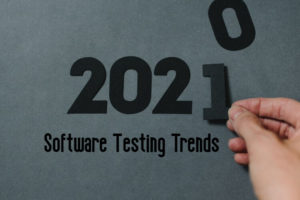Statista reports recorded from 2002 to 2018 make us see that mobile phones indeed run the world, as 52.2% of all global web traffic is sourced from mobile phones.
While it`s likewise interesting to note that the mobile application testing services market is expected to grow to 8.23 B revenue by 2025, as seen in the World Quality Report 2019, test automation’s limited use is one of the main bottlenecks in QA.
More so, if the time of testing is vital, which is likely for mobile testing, limiting the number of manual tasks in the Software Testing Life Cycle is a matter of survival. This further highlights the inevitable need to automate most of the processes.
In this read, we shall define and differentiate mobile automation testing from mobile app automation testing. We will explain the various types of automation tests that we do for our clients, while offering mobile app testing services and also describe how mobile automation testing may be realized.
What is Mobile Automation Testing?
To answer, we need first to clarify that “mobile automation testing” is different from “mobile app automation testing”—the latter concerns testing the mobile applications within the device. However, the former is concerned with testing both the hardware and software units of a mobile device. As we know, mobile devices consist of hardware and software components, while a mobile application is simply the software. Testing the mobile device is also connected to evaluating the hardware component and the software part.
Mobile Hardware Automation Testing
The hardware part is made up of the motherboard, the touchpad, the camera lens, the antenna, the charging port, the power button, the volume button, the light-emitting diodes, the screen, the speaker, the microphone, the battery, the sim card slot, the memory card slot, the earpiece port, the light sensor, etc.
Mobile Software Automation Testing
It is important to note that the software part is not just made up of mobile applications alone. The software part, which is facilitated by the motherboard and all the other hardware, is made up of the
- RAM (random access memory)
- internal memory,
- operating system
- Bluetooth, the
- WiFi, the
- portable hotspot, the
- kernel, the
- certificates, the
- operating system’s security, the
- processor, the
- various applications that make the mobile device usable, etc.
Hardware & Software Synchrony In Automation Testing
During mobile automation testing, both the hardware and software go through testing processes that require little or no human intervention. The hardware part is tested by connecting the mobile device to an automation testing system via a cord or remotely accessing an automation testing module. The automation system goes through the hardware one after the other by activating its internal/ software functions.
In other words, because all the hardware has corresponding software functions, the automation testing system starts each software function related to each of the hardware. For instance, to test the light-emitting diodes, the automation system activates its software for the lights to come on.
Hardware automation testing systems are also used to ensure a connection between the hardware and the corresponding software to control the hardware while using the device.
Another instance is that you can control the mobile device’s volume through the hardware buttons or its software by clicking the volume figure on the device’s screen. Hardware like the camera lenses can only be used by activating the software on the device.
System Diagnostics Modules
Another term used to describe mobile device automation testing is Mobile Diagnostics. Many mobile system diagnostics modules either require the mobile device to be physically present or not for testing. All the hardware and software (apart from the various applications) listed earlier are tested sequentially in both techniques, such as battery health, audio controls, ports sensitivity, connectivity (Bluetooth, WiFi), operating system security, RAM, internal storage, etc. Simply put, a system diagnostics module is used to carry out mobile automation testing on both the hardware and software (except the applications) that make up the mobile device.
How To Carry out Mobile Application Automation Testing
After successfully testing the hardware and software that make up the mobile device, the next part of the mobile automation testing would be to test the applications that make the device usable. Applications are automatically tested individually within a digital environment, also known as a testbed or an automation testing tool. Each tool relies on specific test automation frameworks that try to simplify automation.
Various automated tests can be carried out on mobile applications such as Interrupt testing, Compatibility testing, Penetration testing, etc.
Interrupt testing is an automation testing process that ascertains an application’s ability to continue operating while another device application is simultaneously running. For instance, how does an application react when a call or message comes in. Some applications don’t function as they should once be minimized or when another application receives or sends a notification that temporarily overshadows it.
Another type of automation test is the Compatibility test, which is carried out to ascertain how well an application works within a specific operating system. Most applications come with specifications that describe the lowest system requirements for use in a mobile device. Those specifications help the end-users to know if the application is compatible with their mobile device or not.
The compatibility test does determine how well an application can synchronize with one or more other applications on the same or in a different device. Connections between two or more applications on the same or different mobile devices are almost inevitable for certain transfers or other networking needs. They have to be compatible with each other for a productive connection.
Penetration testing is a popular type of automation testing carried out on both simple and complex software. An application must go through a penetration test performed by professional, ethical hackers. This will boost the security of the application and ensure that it is not easily infiltrated. If a hacker gains unauthorized access into an application, he/ she can as well move into other areas of the mobile device from the one hacked initially. Penetration testing gives end-users the assurance and confidence to use, re-use, and recommend an application.
| Recommended: what is penetration testing? |
Tools for Mobile Application Automation Testing
Some of the most commonly used mobile application automation testing tools are:
Kobiton, Test project, Squish By Froglogic, Apptim, TestingBot, 21, Appium, Selendroid, MonkeyRunner, Calabash, KIF, Testdroid, etc. These tools are like digital environments where the application is put into throughout the test.
The tester will have to utilize these tools and the right automation testing frameworks to perform an effective test.
Test Automation frameworks
The test framework can be seen as the entire structure that makes up the tool or merely the skeleton holding up the test environment.
Automation testing frameworks include;
- Linear, which carries out tests in a structured, less flexible approach.
- Modular carries out tests by dividing the application into various functions and testing them individually.
- Library Architecture carries out tests by further grouping the isolated functions based on their similarities.
- Data-Driven which carries out tests by allowing external storage containing data associated with the application to be connected to the test environment.
- Keyword-Driven, which categorizes the functions of the application by similar words. For instance, the term “process data” can organize uploading photos, receiving documents, etc.
- Hybrid Testing Framework contains all the features of all the other frameworks combined. This Framework is the most complex yet the most flexible to use. It can be used to test any application and is ideal for testing hybrid applications.
In conclusion, mobile automation testing is quite broad; however, it is crucial and cannot be overlooked by mobile device manufacturers and mobile application developers. It should be carried out
- during the manufacturing process of the mobile device,
- during the development process of the mobile application,
- after the manufacturing process of the device,
- after the development process of the application,
- after the device has been launched, and after the application has been launched to the public.
After launching to the public, continuous mobile automation testing helps decide which areas require improvements, giving rise to upgrades in mobile device versions, operating systems, and updated mobile applications.








